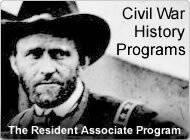
A Just and Lasting Peace
The Smithsonian Associates Civil War E-Mail Newsletter, Volume 8, Number 4
1862 was the second summer of a war that most thought would last just a few months. As the casualties mounted from the battles at Wilson's Creek, Bull Run, Shiloh, and Fort Donelson, it was clear this war would be long. A plan was needed to ensure that the Americans killed in it would be honored with the dignified burials they deserved.
That July Congress enacted legislation authorizing the procurement of grounds for use as national cemeteries. Fourteen cemeteries were established the first year, including one in the Maryland town of Sharpsburg where 4,476 Union soldiers were laid to rest after the terrible first day of the Battle of Antietam. (Antietam still is the bloodiest one-day battle in American history, where Union and Confederate casualties, both killed and wounded, totaled 17,300.)
After the Civil War, Army crews scoured the countryside to locate the remains of hastily, and sometimes un-buried, soldiers. By 1870, nearly 300,000 Civil War dead had been buried in the 73 national cemeteries thus far established. Sadly, due to time and the chaotic heat of battle, the identities of nearly half of those re-buried remain unknown.
Today there are 139 national cemeteries holding the remains of those who fought in all of America's wars. The Veterans Administration, through its National Cemetery Administration, oversees 123 of them. Recently, the NCA Memorials Inventory Project documented over 1000 memorial objects in these cemeteries. Memorial objects include carillons, gun monuments, plaques, and stones. The vast majority of these are related to the Civil War, including the latest, a statue dedicated to the United States Colored Troops at Nashville National Cemetery in Tennessee.
Almost all the funds to pay for this statue came from private donations, including contributions from the Sons of the Confederacy. The model for the nine-foot bronze infantryman was Bill Radcliff, a Nashville firefighter and Civil War re-enactor with the 13th USCT.
Unveiled in February 2006, it is the only freestanding monument in a national cemetery dedicated to African American soldiers. Its location in Tennessee is fitting as well. Of the almost 200,000 African American soldiers who fought in the Civil War, the "Volunteer State" furnished over 20,000. This was in sharp response to the skeptics who shrilly questioned, "Will the Negro fight?"
This monument to African American soldiers embodies President Lincoln's belief that the Civil War was the nation's punishment for the offense of slavery. At the same time, Lincoln's provision for a national cemetery system ensured that all those, both black and white, "who shall have borne the battle, and for his widow and his orphan..." would be recognized for their supreme sacrifice.
Our country now must work to complete the remaining goals of Abraham Lincoln's Second Inaugural Address, "to do all which may achieve and cherish a just and lasting peace among ourselves and with all nations."

